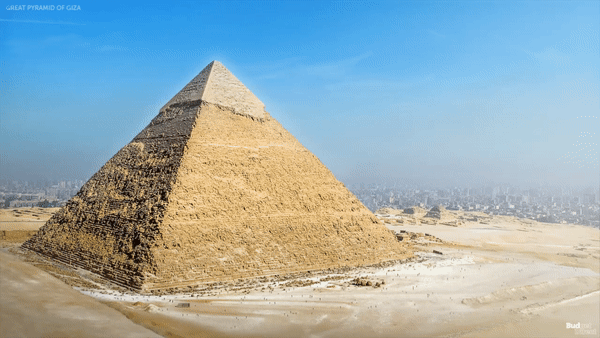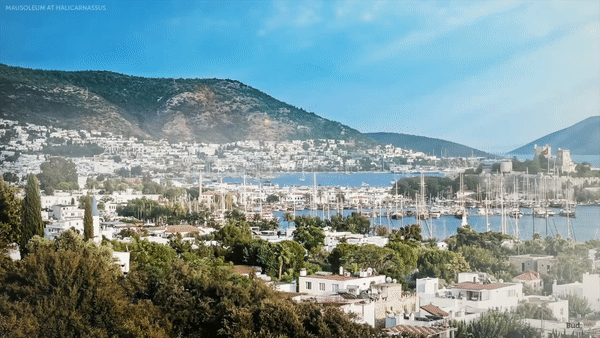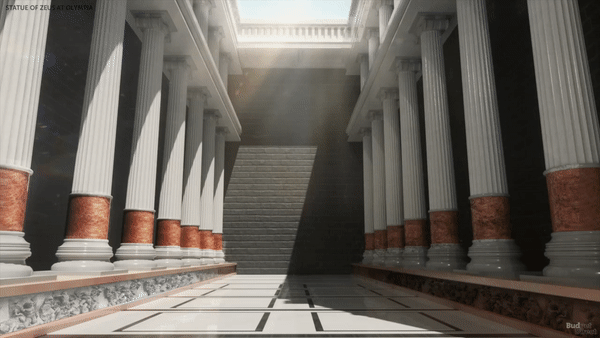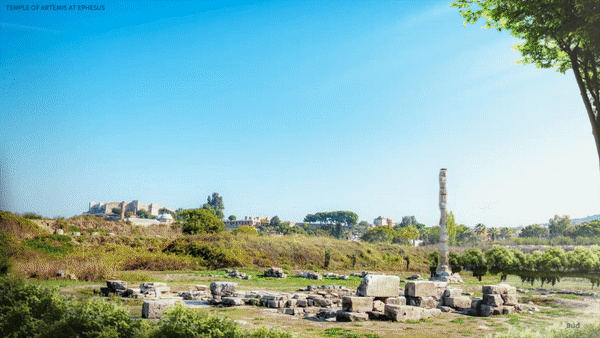The 7 Wonders of the World – Digitally Reconstructed
The Wonders of the Ancient World remain cornerstones of human culture, and the concept is regularly referred to in casual conversation as well as in the academic sphere. But how many people can actually name all seven wonders – and then, how many can imagine how they might actually have figured before the turn of the common era?
For a start, six of the ancient wonders have vanished – and that’s if they existed in the first place. The original list of wonders was compiled as a kind of travel guide by Antipater of Sidon, a 2nd-century-BCE Greek poet, and it seems unlikely that he himself would have had the means to visit all these landmarks (and, presumably, others that didn’t make the shortlist) in his lifetime. Some of his choices – such as the Hanging Gardens of Babylon – were probably based on the writings of others, which may not have been reliable or correctly interpreted.
A team of researchers and 3D artists over at Budget Direct have worked with the existing sources we have for the missing wonders, and created digital reconstructions of how they would have looked like (they’ve also touched up the sole surviving wonder, the Great Pyramid of Giza, to restore it to its former glory). They sourced written details about the materials, measurements, and architectural features of the landmarks – as well as their cultural backgrounds. Drawings and secondary visual sources were also passed along to the artists, who “looked closely at locations, dimensions, plans, statues, ornamentations, patterns, textures, colors, materials and finish” while they worked – sometimes making judgement calls between conflicting sources.
The results are a leap through time to a different age of bucket-list tourism.
1. Colossus of Rhodes

The Colossus of Rhodes, Reconstructed, courtesy of Budget Direct Travel Insurance
First up is the Colossus of Rhodes, an immense 108ft statue raised to mark the city’s victory over the Cypriot army – and also to warn other would-be invaders of the home army’s might. They even melted down the iron and bronze weaponry left behind by the vanquished Cypriots to use for the shell, although the inside was weighed down with stones.
The marble pedestal beneath the Colossus (which was the likeness of the peoples’ patron god, Helios) pushed the total height up to 157ft, possibly in a position for ships to pass between his legs. Well, nobody said it was tasteful. Anyway, the monument stood for just 54 years before being toppled not by an invading navy, but by a massive earthquake. It remained a powerful tourist attraction even in recline, until Muslim caliph Muawiyah I took the island in 693CE and sold the metal Colossus for scrap.
2. Great Pyramid of Giza

The Great Pyramid of Giza, Reconstructed, courtesy of Budget Direct Travel Insurance
The Great Pyramid of Giza was constructed around 2589-2566 BCE, and remained the tallest human-made structure on Earth until the 14thcentury CE. Nobody knows exactly how the Egyptians built Pharaoh Khufu’s 481ft pyramid, but it seems likely that skilled workers travelled to Giza from across the land to live in well-kept camps onsite. Strong arms and minds using now-forgotten knowledge were well fueled with good food and highly-motivated to create structures of national pride which established Ancient Egypt as the powerful culture we now celebrate.
Today, the unrenovated pyramid is recognizable by its stone step structure. But the creators of this digital reconstruction have replaced the flat, polished white limestone blocks that originally formed the façade of the pyramid – many of these stones were loosened by an earthquake in 1303, giving it the familiar jagged look.
3. Hanging Gardens of Babylon

Hanging Gardens of Babylon, Reconstructed, courtesy of Budget Direct Travel Insurance
The Hanging Gardens of Babylon may never have existed and, if they did, they may have existed300 miles north of Babylon (and thus 250 miles north of modern Baghdad) in Ninevah. Dr Stephanie Dalley of Oxford University claims that Nebuchadnezzar, king of Babylonia’s claims to having created the gardens could have been an attempt to beef-up his legacy. "After his death legends inflated Nebuchadnezzar's achievements, giving him an undeserved reputation as a world conqueror," says Dalley.
Indeed, Babylonian texts make no mention of the gardens. But other writers describe them as a paradise of plants, sculptures, and water features, apparently served by an impressive machinery drawing water to a height of 65ft from the river below.
4. Lighthouse of Alexandria

Lighthouse of Alexandria, Reconstructed, courtesy of Budget Direct Travel Insurance
The prototypical lighthouse was built by Sostratus of Cnidus around 280BCE. It was probably the second highest structure in the world at the time – after the Giza pyramids, in collective first place. It was formed of a square shape, on top of which was an octagon, and with a cylindrical tower at the top (some sources suggest it was crowned by a statue of Alexander the Great).
The lighthouse fell into ruin between the 12th and 15th centuries BCE, at which point the Ottoman prince Sultan Cem built a fort on the foundations. An archeological dive in 1994 discovered masonry blocks as well as statues of Ptolemy II and his wife, Arsinoe off the coast of Pharos Island. Experts believe they tumbled from the lighthouse complex during a 14th-century earthquake.
5. Mausoleum at Halicarnassus

Mausoleum at Halicarnassus, Reconstructed, courtesy of Budget Direct Travel Insurance
Mausolus, the king who would give the concept of the mausoleum his name, was the ruler of Caria in ancient Asia Minor. He had many great buildings erected during his reign, and his final resting place was exemplar of numerous architectural trends.
Borrowing from Greek, Near Eastern, and Egyptian design principles, the structure was composed of Anatolian and Pentelic marble and featured Ionic colonnade with a stepped pyramidal roof, topped with a statue of Mausolus as Hercules riding a chariot.
6. Statue of Zeus at Olympia

Statue of Zeus at Olympia, Reconstructed, courtesy of Budget Direct Travel Insurance
The chryselephantine (ivory and gold) statue of Zeus was created by the sculptor Phidias around 430 BCE. You can see the scepter in his left hand has an eagle perched on top, while the statue to his right represents Nike (the goddess of victory).
The throne was made of cedarwood and ebony, and ornamented with jewels, ivory, and gold. It took eight years to make, but was probably consumed by fire within just a few decades.
7. Temple of Artemis at Ephesus

Temple of Artemis at Ephesus, Reconstructed, courtesy of Budget Direct Travel Insurance
Despite all the ruins witnessed among the wonders above, it’s a wonder that the Temple of Artemis is not standing today. This tribute to the Greek goddess of chastity recovered from multiple disasters: first burned down by Herostratus – who torched it to make himself famous– it was resurrected only to be wrecked by passing Goths. Rebuilt again, the temple was then destroyed once and for all by a Christian mob. The remains can still be seen today.